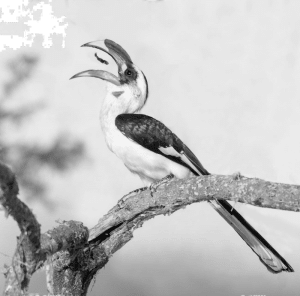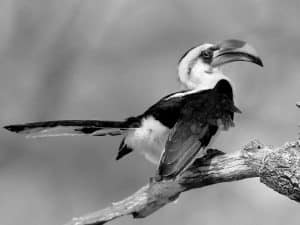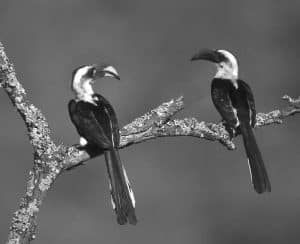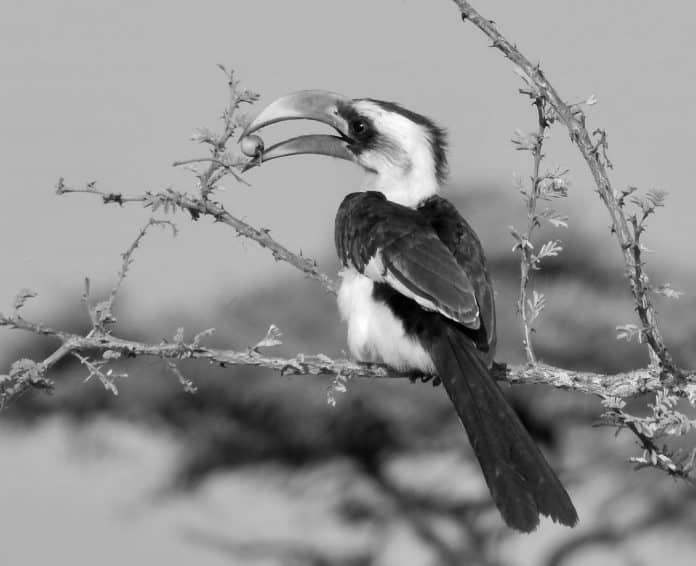Introduction to Von der Decken’s Hornbill
Tanzania, a country known for its rich biodiversity and stunning landscapes, is home to a variety of unique and fascinating wildlife. Among the many species that call Tanzania home, the Von der Decken’s Hornbill in Tanzania stands out as a remarkable bird that captivates the attention of both locals and visitors alike. Named after the famous German explorer Baron Karl Klaus von der Decken, this striking bird is a symbol of Tanzania’s diverse and vibrant ecosystem. With its distinct appearance and intriguing behaviors, the Von der Decken’s Hornbill is a species that holds a special place in the hearts of many Tanzanians and nature enthusiasts around the world.
Habitat and distribution of Von der Decken’s Hornbill in Tanzania

The Von der Decken’s Hornbill is primarily found in the eastern regions of Africa, including Tanzania. Within Tanzania, these magnificent birds inhabit a range of diverse habitats, from coastal forests to savannas and woodlands. They are particularly prevalent in the coastal areas of eastern Tanzania, where the dense vegetation and abundant tree cover provide an ideal environment for their nesting and foraging activities. Their distribution also extends to the hinterland, where they can be spotted in the wooded areas near water sources such as rivers and lakes. The ability of the Von der Decken’s Hornbill to thrive in varied habitats is a testament to its adaptability and resilience in the face of environmental changes.
The Von der Decken’s Hornbill’s presence in Tanzania is not limited to specific regions, as they can be found in various national parks and protected areas across the country. These include the iconic Serengeti National Park, Tarangire National Park, and the Selous Game Reserve, among others. Their widespread distribution underscores the significance of these birds within the Tanzanian ecosystem and highlights the need for conservation efforts to ensure their continued survival in the wild.
Physical characteristics of Von der Decken’s Hornbill
The Von der Decken’s Hornbill is a visually striking bird, characterized by its vibrant plumage and distinctive features. One of the most notable physical attributes of this species is its large, downward-curved bill, which is adorned with a casque, or bony growth, on the upper mandible. This unique adaptation serves both practical and aesthetic purposes, as it enhances the hornbill’s ability to forage for food and also contributes to its impressive appearance. The bill’s vibrant coloration, often a striking mix of yellow, red, and black, adds to the bird’s overall allure and makes it a captivating sight for birdwatchers and wildlife enthusiasts.
In addition to its remarkable bill, the Von der Decken’s Hornbill sports a contrasting black and white plumage, with subtle touches of yellow and red on its underparts. Its long tail and broad wings further distinguish it from other bird species in the region, giving it a regal and majestic presence as it soars through the Tanzanian skies. The male and female hornbills exhibit similar physical characteristics, with the male typically being slightly larger in size. These impressive physical traits contribute to the Von der Decken’s Hornbill’s status as a symbol of Tanzania’s natural beauty and ecological diversity.
Behavior and diet of Von der Decken’s Hornbill
The behavior and diet of the Von der Decken’s Hornbill are fascinating aspects of its ecological role in Tanzania’s diverse ecosystems. These birds are predominantly frugivorous, meaning that their diet primarily consists of fruits, berries, and other plant matter. Their keen sense of sight and agile flight enable them to locate and harvest a wide variety of fruits from the forest canopy, making them important seed dispersers within the ecosystem. In addition to fruits, Von der Decken’s Hornbills also consume insects, small reptiles, and occasionally, small mammals, supplementing their diet with a diverse array of food sources.
The social behaviors of Von der Decken’s Hornbills are equally intriguing, as they are often observed in pairs or small family groups. These birds are known for their strong pair bonds, with mated pairs engaging in cooperative behaviors such as nesting, foraging, and raising their young together. Their nesting habits are particularly unique, as they often seek out natural tree cavities or abandoned arboreal termite mounds to create secure and sheltered spaces for their eggs and hatchlings. The parental care and nurturing instincts displayed by Von der Decken’s Hornbills underscore their importance in maintaining the delicate balance of Tanzania’s ecosystems.
Conservation status of Von der Decken’s Hornbill in Tanzania
Despite their widespread distribution and cultural significance, Von der Decken’s Hornbills face various conservation challenges that threaten their long-term survival in Tanzania. The International Union for Conservation of Nature (IUCN) has classified the species as “near threatened,” indicating that it is at risk of becoming endangered if current threats persist or worsen. Habitat loss and fragmentation due to deforestation, agricultural expansion, and human development activities are among the primary factors contributing to the decline of suitable habitats for these iconic birds. Additionally, illegal hunting and trapping for the pet trade pose significant threats to their populations, further exacerbating their vulnerability in the wild.
The conservation status of Von der Decken’s Hornbills underscores the urgency of implementing effective strategies to protect and preserve their habitats in Tanzania. Collaborative efforts between government agencies, conservation organizations, and local communities are essential for mitigating the impact of these threats and ensuring the long-term viability of the species. By raising awareness about the importance of conserving Von der Decken’s Hornbills and their habitats, stakeholders can work together to implement sustainable solutions that safeguard the future of these remarkable birds and the ecosystems they inhabit.
Importance of Von der Decken’s Hornbill in the Tanzanian ecosystem

The Von der Decken’s Hornbill plays a vital role in the ecological dynamics of Tanzania’s diverse habitats, contributing to the health and stability of the surrounding ecosystems. As frugivorous birds, they play a crucial role in seed dispersal, facilitating the regeneration of forests and maintaining the genetic diversity of plant species. By consuming and dispersing a wide variety of fruits and seeds, Von der Decken’s Hornbills contribute to the regeneration of vegetation, thereby supporting the overall biodiversity and ecological balance of their habitats. Moreover, their foraging activities and nesting behaviors create microhabitats that benefit a range of other wildlife species, further enhancing the richness of Tanzania’s natural landscapes.
In addition to their ecological significance, Von der Decken’s Hornbills hold cultural and symbolic importance in Tanzanian traditions and folklore. These birds are revered for their majestic appearance and distinctive calls, which have inspired artistic expressions and cultural symbolism among local communities. Their presence in the wild serves as a reminder of the interconnectedness of all living beings and the inherent value of preserving the natural heritage of Tanzania for future generations. Recognizing the intrinsic value of Von der Decken’s Hornbills in both ecological and cultural contexts is pivotal in promoting conservation efforts that uphold the integrity of Tanzania’s precious ecosystems.
Threats to the survival of Von der Decken’s Hornbill
The survival of Von der Decken’s Hornbills in Tanzania is imperiled by a combination of anthropogenic and environmental threats that compromise their habitats and populations. Habitat loss and degradation due to deforestation, land conversion, and human encroachment are significant challenges that directly impact the availability of suitable nesting sites and foraging grounds for these birds. The conversion of natural habitats into agricultural landscapes and urban developments further diminishes the resources essential for the survival of Von der Decken’s Hornbills, leading to population declines and localized extirpations in certain areas.
Illegal wildlife trade and poaching also pose severe threats to the conservation of Von der Decken’s Hornbills, as these birds are sought after for their striking appearance and unique features. The demand for hornbills in the pet trade and traditional medicine markets drives the illegal capture and trade of these birds, resulting in population declines and detrimental effects on their reproductive success in the wild. Furthermore, the impact of climate change and ecological disruptions adds to the challenges faced by Von der Decken’s Hornbills, affecting the availability of food resources and altering the dynamics of their habitats. Addressing these multifaceted threats is essential for safeguarding the future of these iconic birds and the ecosystems they inhabit.
Conservation efforts and initiatives in Tanzania
In response to the escalating conservation challenges facing Von der Decken’s Hornbills, Tanzania has implemented a range of initiatives and strategies aimed at protecting and preserving the species and their habitats. National parks, game reserves, and protected areas play a pivotal role in providing sanctuaries for these birds, offering safe havens where they can thrive free from the pressures of human activities and disturbances. Collaborative conservation programs involving government agencies, non-governmental organizations, and local communities are instrumental in raising awareness, conducting research, and implementing conservation actions that address the root causes of threats to Von der Decken’s Hornbills.
Community-based conservation efforts that engage local stakeholders in habitat restoration, anti-poaching measures, and sustainable resource management are crucial for promoting coexistence between human communities and wildlife. By involving communities in conservation programs, initiatives can foster a sense of stewardship and shared responsibility for protecting the natural heritage of Tanzania, including the Von der Decken’s Hornbills and their habitats. Education and outreach programs that emphasize the ecological importance of hornbills and the value of biodiversity conservation contribute to building a culture of conservation and environmental stewardship among Tanzanians of all ages.
Furthermore, international collaboration and support from conservation organizations and research institutions are instrumental in providing expertise, resources, and funding for comprehensive conservation efforts in Tanzania. By working together across borders and disciplines, stakeholders can leverage their collective strengths to address the complex challenges facing Von der Decken’s Hornbills and implement sustainable solutions that promote the coexistence of wildlife and human communities. The synergy of these conservation efforts underscores the shared commitment to preserving Tanzania’s natural heritage and safeguarding the future of Von der Decken’s Hornbills for generations to come.
How to observe Von der Decken’s Hornbill in Tanzania

For visitors and wildlife enthusiasts seeking to observe the beauty and grace of Von der Decken’s Hornbills in their natural habitat, Tanzania offers a range of opportunities to encounter these iconic birds. National parks and protected areas, such as the Tarangire National Park and the Selous Game Reserve, provide prime locations for birdwatching and wildlife photography, where Von der Decken’s Hornbills can be spotted in their native environments. Guided nature walks, safari excursions, and birdwatching tours offer immersive experiences that allow visitors to witness the captivating behaviors and stunning plumage of these remarkable birds.
In the coastal forests and woodland areas of eastern Tanzania, where Von der Decken’s Hornbills are prevalent, visitors can embark on guided expeditions to observe these birds as they forage for fruits and interact with their surroundings. The diverse landscapes and rich biodiversity of Tanzania create ideal conditions for unforgettable encounters with Von der Decken’s Hornbills, providing opportunities for nature enthusiasts to gain a deeper appreciation for the interconnectedness of wildlife and ecosystems. By respecting wildlife viewing guidelines and practicing responsible tourism, visitors can contribute to the conservation of Von der Decken’s Hornbills and support sustainable ecotourism practices in Tanzania.
Conclusion
Von der Decken’s Hornbill, a symbol of Tanzania’s natural heritage and ecological diversity, embodies the intricate connections between wildlife, ecosystems, and human communities. From its striking physical characteristics to its vital ecological roles as seed dispersers and cultural symbolism, the significance of Von der Decken’s Hornbill extends far beyond its presence in the Tanzanian canopy. As conservation efforts continue to address the multifaceted threats facing these iconic birds, the collective commitment to protecting their habitats and promoting coexistence between wildlife and human communities remains essential for ensuring their enduring presence in Tanzania’s landscapes.
By fostering a culture of conservation, raising awareness about the importance of Von der Decken’s Hornbills, and engaging in collaborative initiatives that prioritize the preservation of their habitats, Tanzania and its global partners can secure a future where these majestic birds thrive in the wild. Through responsible tourism, sustainable resource management, and community involvement, the inherent value of Von der Decken’s Hornbills in Tanzania’s natural heritage can be upheld, inspiring generations to cherish and safeguard the rich biodiversity that defines the Tanzanian canopy’s tropical crown.

































